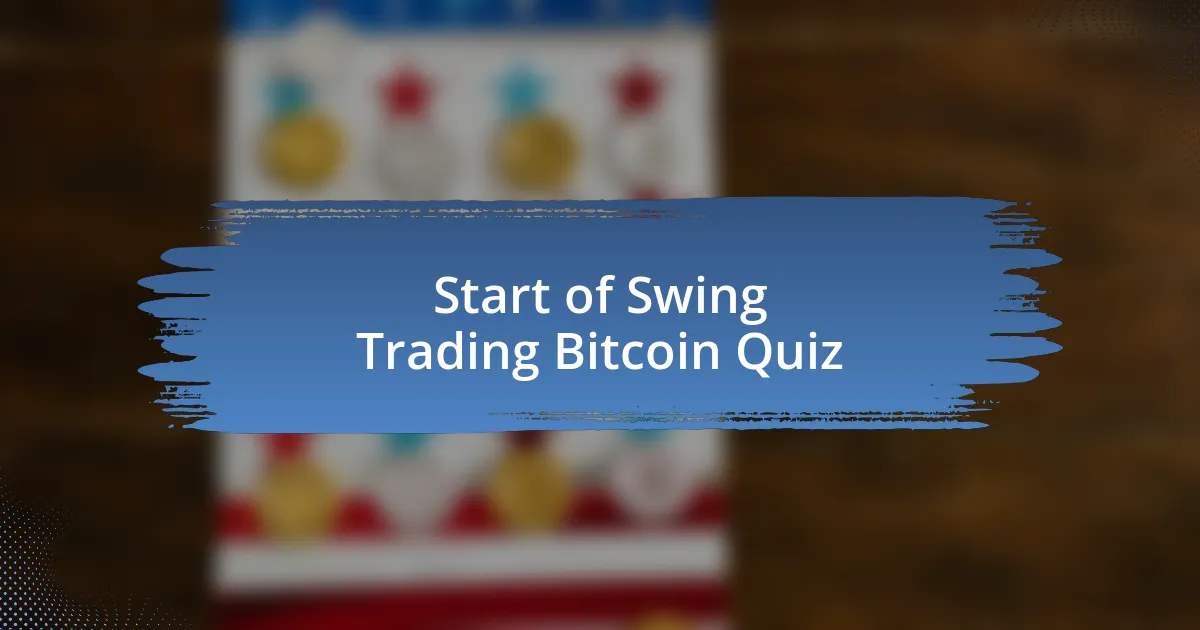
Start of Swing Trading Bitcoin Quiz
1. What is swing trading?
- A strategy that exclusively focuses on holding assets for years without trading.
- A technique for trading that depends solely on news events without considering market trends.
- A hybrid trading strategy that falls between short-term “day trading” and long-term “trend trading” or “narrative trading,” involving buying and selling crypto assets at market swings.
- A trading method that only uses fundamental analysis without any technical indicators.
2. What is the time frame for swing trading?
- An entire trading day.
- A few minutes to hours.
- Several months to years.
- A few days to weeks.
3. What analysis is most commonly used in swing trading?
- Technical analysis
- Arbitrage analysis
- Sentiment analysis
- Fundamental analysis
4. What are the five rules of swing trading?
- Always invest the maximum capital, trade all price movements, ignore support and resistance, avoid any technical analysis, and follow other traders blindly.
- Plan your swing trade based on the market situation, get into your crypto swing trade gradually, set clear entry and exit points, keep an eye on the cryptocurrency’s price movement, and use technical indicators.
- Choose random assets without analysis, set vague targets, ignore market trends, focus only on long-term gains, and trade without planning.
- Rely solely on news articles, make trades impulsively, forget about stop-loss orders, trade any time regardless of performance, and use only one indicator.
5. What is the Fibonacci Retracement strategy?
- A method for calculating future stock prices based on historical averages.
- A technique for managing portfolios using random number selections.
- A strategy focusing solely on short-term trades without considering trends.
- A trading strategy using horizontal lines from the Fibonacci sequence to indicate support and resistance levels.
6. What is the Bollinger Bands Method?
- A method relying on historical news events to forecast future price movements.
- A method using three bands (upper, lower, and moving average) to indicate market direction and overbought/oversold conditions.
- A technique that focuses solely on price trends without any additional indicators.
- A strategy using only volume data to predict market movements without price analysis.
7. What is the Trend-Catching Strategy?
- An approach that emphasizes fundamental analysis over market trends.
- A strategy focused solely on short-term trading without trend considerations.
- A strategy that involves recognizing trends to identify better entry and exit points, maximizing gains and minimizing losses.
- A method using charts and patterns to predict future price movements.
8. How do you choose coins for swing trading?
- Choose coins randomly without analysis.
- Research market volatility and use technical indicators.
- Invest only in low-priced coins regardless of market conditions.
- Buy coins based on social media trends.
9. What is the best time for swing trading?
- When stock prices are consistently rising.
- When trading hours are at their lowest.
- When market volatility and market participation are high.
- When the market is closed for holidays.
10. What are the key indicators to gauge the state of the market?
- Bitcoin price volatility, Bitcoin market dominance, BTC/ETH ratio, Bitcoin’s 20-day SMA.
- Company earnings reports, dividend yields, inflation rates, consumer spending habits.
- Historical average prices, government policies, investor sentiment trends, social media engagement.
- Total trading volume, number of active traders, stock market index, price earnings ratio.
11. What is the Trend Following strategy?
- Buying and selling at predetermined intervals based on historical data.
- Identifying and riding the prevailing trend using technical indicators like moving averages and trend lines.
- Focusing solely on news events affecting market sentiment and prices.
- Trading volatile assets only during major market hours and ignoring trends.
12. What is Counter-Trend Trading?
- Profiting from price reversals by entering trades opposite to the prevailing trend.
- Following the market trend to maximize profits on trades.
- Investing in long-term assets with little active management.
- Buying low and selling high within a defined trading range.
13. What is Breakout Trading?
- Selling assets to limit losses during a market downturn.
- Capturing significant price movements when the price breaks out of a defined trading range or chart pattern.
- Purchasing cryptocurrencies for long-term investment without regard for price movements.
- Entering trades based on fundamental economic reports and news.
14. How do you set entry and exit points in swing trading?
- Use random time intervals without any market analysis.
- Define the prices at which you are entering and exiting a trade to make a profit or avoid a loss.
- Predict the prices based on news articles and public sentiment.
- Set arbitrary prices based on personal preference and intuition.
15. What is the importance of support and resistance levels in swing trading?
- Support and resistance levels only show the best times to buy stocks.
- Support and resistance levels only apply to long-term investments.
- Support and resistance levels help traders determine entry and exit plans by indicating where prices are likely to form.
- Support and resistance levels are irrelevant in day trading strategies.
16. What are some common chart patterns in swing trading?
- Triangles, flags, and pennants.
- Candlestick patterns, daily volume spikes, and moving averages.
- Random price movements, historical trends, and psychological levels.
- Double tops, single bottoms, and head-and-shoulders.
17. How does backtesting software help in swing trading?
- It helps practice entries and exits, giving skills and intuition to get in and out of the markets efficiently.
- It guarantees profits through automated trading without human intervention.
- It determines market direction using economic data to predict trades.
- It replaces the need for technical analysis by focusing solely on news events.
18. What is the role of fundamental analysis in swing trading?
- It provides detailed projections of future price trends based on historical data.
- It exclusively focuses on the psychological aspects influencing market behavior.
- It eliminates the need for technical indicators in trading decisions.
- It helps factor in the latest developments to make the most of price swings while ensuring profits don’t slip away.
19. What is the significance of market capitalization and liquidity in choosing coins for swing trading?
- High market capitalization and low liquidity increase the chances of loss.
- Low market capitalization and high volatility minimize trading opportunities.
- Market capitalization is irrelevant while liquidity guarantees better returns.
- Higher market capitalization and liquidity ensure entry and exit without price slippage.
20. How does the Bollinger Bands Method combine with other indicators?
- It solely relies on historical price patterns and trends without any indicators.
- It primarily focuses on news and events rather than technical indicators.
- It frequently combines with the relative strength index (RSI) and the bandwidth indicator.
- It exclusively uses moving averages and ignores other tools in analysis.
21. What is the importance of trend identification in swing trading?
- It guarantees profits without risk in every trade.
- It relies solely on historical data and ignores market trends.
- It focuses only on long-term trading strategies for success.
- It helps identify better entry and exit points, maximizing gains and minimizing losses.
22. What are the key elements of a successful swing trading strategy?
- Focusing solely on fundamental analysis without technical aspects.
- Clear entry and exit points, continuous mentoring, and adapting to changing trends.
- Ignoring market trends and news events entirely.
- Random trading without analysis or planning.
23. How does the trend-following strategy protect capital?
- By focusing solely on fundamental analysis of the assets.
- By using high leverage to increase profits quickly.
- By diversifying investments across multiple assets.
- By entering trades in the direction of the trend and setting tight stop-loss orders.
24. What is the role of moving averages in trend following?
- Moving averages only indicate support and resistance levels without trend analysis.
- Moving averages are primarily focused on fundamental analysis of stocks.
- Moving averages are used solely for predicting short-term price swings.
- Moving averages help capture significant trends by indicating whether the price is above or below the average.
25. How does the counter-trend trading strategy work?
- Avoiding resistance and support levels entirely.
- Only buying assets at their lowest price points.
- Profiting from price reversals by entering trades opposite to the prevailing trend.
- Trading with the same direction as the market trend.
26. What is the significance of chart patterns in identifying trading opportunities?
- Chart patterns have no impact on trading decisions in the market.
- Chart patterns are solely used to set stop-loss orders for trades.
- Chart patterns like triangles, flags, and pennants help traders spot potential swing trading opportunities.
- Chart patterns indicate the exact price for buying stocks only.
27. How does the breakout trading strategy work?
- It relies solely on news events to make trading decisions.
- It focuses on holding assets for many years without trading.
- It involves capturing significant price movements when the price breaks out of a defined trading range or chart pattern.
- It is purely based on fundamental analysis without regard to trends.
28. What is the importance of staying current with news and events in swing trading?
- It helps traders stay informed about market impacts and adjust their strategies accordingly.
- It provides guaranteed profits regardless of market conditions.
- It ensures that traders can predict future prices accurately.
- It eliminates the risks associated with trading altogether.
29. How does the relative strength index (RSI) help in swing trading?
- It helps identify overbought and oversold conditions by measuring the magnitude of recent price changes.
- It calculates average trading volume to signal buying or selling points.
- It predicts future price movements based on historical trends alone.
- It indicates the total market volatility without specific asset focus.
30. What is the significance of volatility in swing trading?
- Volatility increases the chances of profit as it leads to significant price movements.
- Volatility eliminates all risk in swing trading.
- Volatility has no impact on trading decisions or price movements.
- Volatility guarantees consistent returns in every trade.

Congratulations! You’ve Successfully Completed the Quiz
Well done on finishing the quiz on Swing Trading Bitcoin! We hope you enjoyed the process and learned valuable insights about this intriguing trading strategy. Swing trading offers a way to capitalize on price fluctuations in Bitcoin, and it’s essential to grasp the key concepts and techniques involved.
Throughout the quiz, you may have discovered various aspects of market analysis, risk management, and the importance of timing. Understanding these elements is crucial for becoming a successful swing trader. Familiarity with indicators and chart patterns can also help refine your approach and improve your trading outcomes.
If you want to deepen your knowledge of Swing Trading Bitcoin, we invite you to explore the next section on this page. You’ll find a wealth of information that can help you enhance your trading skills and strategies. Expand your understanding and take confident steps in your trading journey!

Swing Trading Bitcoin
Understanding Swing Trading in Bitcoin
Swing trading in Bitcoin refers to a trading strategy that aims to capture short to medium-term gains. Traders typically hold positions from a few days to several weeks. This strategy requires a keen analysis of market trends and price fluctuations. Unlike day trading, which focuses on capturing smaller price movements, swing trading seeks larger price swings. The main goal is to profit from price volatility, providing traders the flexibility to engage with the market without constant monitoring.
Key Indicators for Swing Trading Bitcoin
Key indicators for swing trading Bitcoin include moving averages, Relative Strength Index (RSI), and Fibonacci retracement levels. Moving averages help identify the market trend by averaging price data over a specific period. The RSI provides insights into overbought or oversold conditions, signaling potential reversal points. Fibonacci retracement levels assist traders in determining potential support and resistance levels during price corrections, guiding entry and exit points.
Risk Management Strategies in Swing Trading
Risk management is crucial in swing trading Bitcoin to protect capital and minimize losses. One common strategy is setting stop-loss orders, which automatically exit a trade if the price hits a predetermined level. Additionally, traders often use position sizing to manage how much capital to risk on each trade. Diversifying trades across different timeframes and currencies can also mitigate risks associated with Bitcoin’s volatility.
Choosing Entry and Exit Points in Swing Trading Bitcoin
Choosing entry and exit points is essential in swing trading Bitcoin. Traders often look for chart patterns such as head and shoulders or double tops/bottoms as indicators for entering positions. Exit points are typically determined based on target profit levels or technical indicators signaling a reversal. Monitoring news events and market sentiment can also influence timing decisions, enhancing the chances of successful trades.
Common Swing Trading Mistakes in Bitcoin
Common mistakes in swing trading Bitcoin include overtrading and neglecting risk management. Overtrading occurs when traders engage in too many positions, leading to exhaustion and poor decision-making. Additionally, failing to set stop-loss orders may result in significant losses during market downturns. Emotional trading, driven by fear or greed, can also lead to illogical decisions, disrupting the planned trading strategy.
What is swing trading in Bitcoin?
Swing trading in Bitcoin is a trading strategy that focuses on capitalizing on short to medium-term price movements. Traders analyze price charts and market trends to identify entry and exit points for positions that typically last from a few days to several weeks. According to a 2021 study by the University of Technology Sydney, traders can maximize gains by using technical analysis indicators such as moving averages and the Relative Strength Index.
How do you start swing trading Bitcoin?
To start swing trading Bitcoin, one must first open an account on a cryptocurrency exchange that supports Bitcoin trading. After funding the account, traders analyze price patterns and select entry and exit points based on their strategy. Tools like TradingView or MetaTrader can assist in identifying market trends. A survey by the Binance Research in 2022 noted that beginners often utilize these platforms for effective analysis.
Where can you find swing trading strategies for Bitcoin?
Swing trading strategies for Bitcoin can be found on various financial websites, trading forums, and educational platforms. Websites such as Investopedia offer articles and tutorials on swing trading techniques. Additionally, social media platforms like Twitter and Reddit have communities where traders share their strategies and experiences. A report by CoinMarketCap indicated that educational resources significantly improve trading success rates for beginners.
When is the best time to swing trade Bitcoin?
The best time to swing trade Bitcoin generally coincides with high volatility periods, often occurring after major market events or news releases. Traders should pay attention to significant economic announcements and the Bitcoin halving events, which historically lead to increased trading activity. A study by CoinTelegraph in 2020 highlighted the correlation between market volatility and increased profit opportunities for swing traders.
Who are the most successful swing traders in Bitcoin?
Some of the most successful swing traders in Bitcoin include well-known figures in the cryptocurrency space, such as Peter Brandt and Scott Melker. They have built reputations through successful trading strategies and substantial returns. Data from various cryptocurrency trading platforms indicate that traders who follow their analyses and market predictions have historically achieved higher success rates in swing trading Bitcoin.


